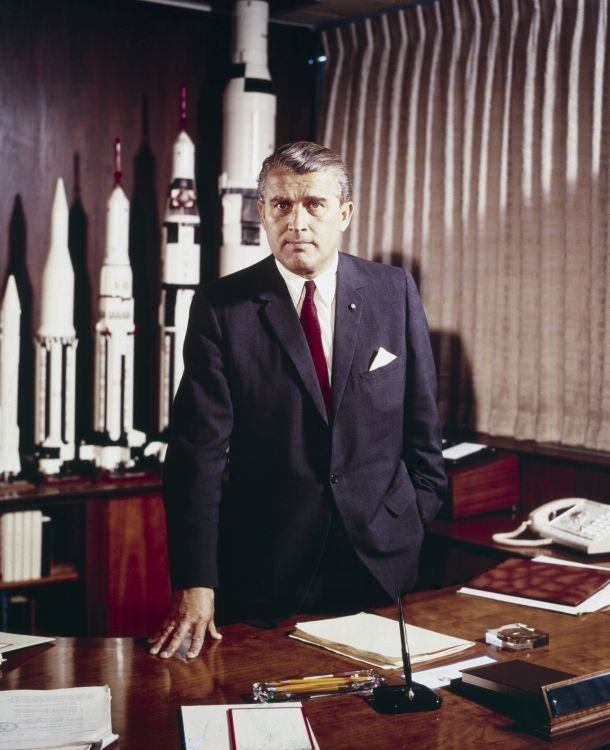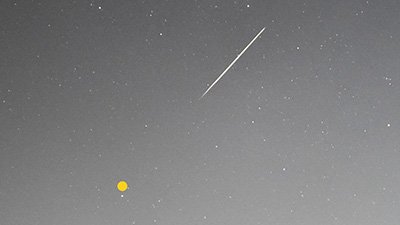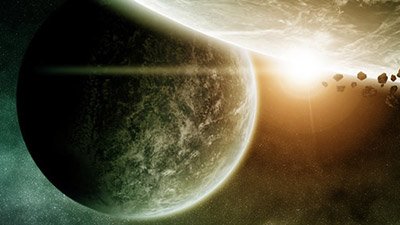
A Brief History of Rocket Science
How believers in biblical creation started rocket science in the twentieth century and the study’s continued dependence upon the orderly construction of the universe by God
Introduction
And God said, “Let there be lights in the expanse of the heavens to separate the day from the night. And let them be for signs and for seasons, and for days and years, and let them be lights in the expanse of the heavens to give light upon the earth.” And it was so. And God made the two great lights—the greater light to rule the day and the lesser light to rule the night—and the stars. And God set them in the expanse of the heavens to give light on the earth, to rule over the day and over the night, and to separate the light from the darkness. And God saw that it was good. And there was evening and there was morning, the fourth day. (Genesis 1:14–19)
We clearly see in the very first chapter of the Bible in Genesis that God created everything in the heavens and the earth during the first week of creation. And on that fourth day of creation, he created the sun, moon, and stars (i.e., everything in space) and called it good. Yet, sadly, many in our culture today just assume that Christianity and space-exploration (rocket) science are not even related.
And this stigma has undoubtedly been driven by secular media, specifically by famous atheists, such as Stephen Hawking (famous British astrophysicist who lived 1942–2018). For example, he once said during an interview, “Before we understand science, it is natural to believe that God created the universe. But now science offers a more convincing explanation. What I meant by ‘we would know the mind of God’ is, we would know everything that God would know, if there were a God, which there isn’t. I’m an atheist.”1
However, by examining just a brief history in rocket science, we’ll see that it was actually Christians (not atheists) in the industry who gave rise to our modern space-exploration era. Most notably, it all really started with the original pioneer (and father) of rocket science—Wernher von Braun.
The Father of Rocket Science Was . . . Christian?

Dr. Wernher von Braun. Image via NASA/MSFC.
The age of rocket science really blasted (pun intended) into popularity in 1957, when the Soviet Union launched its first satellite, Sputnik, into orbit. Although this satellite was only in orbit for about 98 minutes, this event really sparked (pun intended) the beginning of the modern space-exploration era that would dominate science and culture at large for the next several decades.
Shortly after that, in 1958, Wernher von Braun (a German rocket scientist who came to the United States at the end of World War II) was made director of the space division for NASA. And just a few months later after Sputnik, he was then given the go-ahead to use a Jupiter rocket (originally developed for the US weapons program) to launch the satellite Explorer I, thus igniting (pun intended) the space race between the Americans and the Soviets.
This brilliant man, von Braun, was really the heart and soul and mastermind of the space program during this time, but many people don’t realize he was also a devout Christian, who believed in the biblical creation2 account as depicted in the first chapter of the Bible (Genesis 1). He would frequently proclaim the truth of the Bible, describing it as “the revelation of God’s nature and love.”3 He also regularly prayed (sometime reciting the Lord’s prayer) for the safety of each manned spaceflight.
On top of that, von Braun was a staunch opponent of evolution and naturalistic thinking (which was quickly becoming the dominant worldview in the culture at that time). In particular, he was a strong critic of the tendency to teach science from an evolutionary view. He wrote extensively on this subject with statements like:
There are those who argue that the universe evolved out of a random process, but what random process could produce the brain of man or the system of the human eye?4
I find it . . . difficult to understand a scientist who does not acknowledge the presence of a superior rationality behind the existence of the universe.5
More importantly, von Braun did not see his work as glorifying man’s achievements; rather, he investigated the heavens in awe of our great Creator God. He said, “manned space flight is an amazing achievement, but it has opened for mankind thus far only a tiny door for viewing the awesome reaches of space. An outlook through this peep-hole at the vast mysteries of the universe should only confirm our belief in the certainty of its Creator.” And ultimately, his work and dedication in exploring space to the glory of God paved the way for us to put boots on the moon.
The Path to the Moon Led by Christian Astronauts
A few years later, in 1961, in response to the presidential directive from John F. Kennedy to make America the first nation to send men to the moon (mainly for military superiority), von Braun and his team then developed a series of Saturn (1, 1B, and V) rockets that were specifically designed for the manned space programs: Mercury, Gemini, and Apollo.
Then in 1962, President John F. Kennedy delivered his iconic “we choose to go to the moon” speech6 (further declaring that the US would land men on the moon by the end of the decade). And this was shortly after a Soviet cosmonaut (Yuri Gagarin) took flight to be the first man in space via the spacecraft Vostok 1, thus helping to fuel (pun intended) the Apollo program to send US astronauts to the moon.
Later that decade, in 1968, the first manned mission (Apollo 8) finally orbited the earth, effectively testing the rocket and vehicle systems prior to heading to the moon. And amazingly, this event was shown on live television on that Christmas Eve, where the onboard astronauts actually read from the first chapter of Genesis,7 thus praising God for his creative works!
But unfortunately, the NASA administrators had to deal with a lawsuit from an “atheist activist” (Madalyn Murray O’Hair8) who claimed this act of reading Scripture by the astronauts was a violation of the “separation of church and state,” accusing the agency of not being “neutral” (which obviously was just a form of pretended neutrality fallacy; i.e., the unbeliever pretending to be neutral). From the Bible, we know there’s clearly no such thing as “neutral ground” (Matthew 12:30), so the atheist, even though claiming to be neutral, was not. Nonetheless, by God’s providence, the case was eventually dropped.
Finally, in 1969, the famous Apollo 11 mission successfully sent three astronauts (Neil Armstrong, Edwin “Buzz” Aldrin, Michael Collins) to physically touch down on the moon for the first time in history. And prior to landing, Buzz Aldrin (who was an ordained Presbyterian elder at the time) successfully took communion (Lord’s supper) aboard the lunar lander while reading from John 15:5. He also brought with him a physical scrap of this Scripture to the moon.9
And shortly after, during the Apollo 14 mission, there were even Bibles that were successfully taken to the moon! The astronaut Edgar Mitchell managed to take 300 small (microfilm) King James Bibles to the surface and return them to earth. And they are still intact today, commonly called “Lunar Bibles.”10
There were also many other notable astronauts during this time who were Christian, such as John Glenn (Mercury-Atlas 6), Ed White (Gemini IV), Gordon Cooper (Mercury-Atlas 9 and Gemini V), Frank Borman (Apollo 8), Jim Irwin (Apollo 15), and Charlie Duke (Apollo 16). And that’s just to name a few!
But then, sadly, as the Apollo programs came to a close with Apollo 17, many Christian leaders at NASA began leaving the organization (including von Braun, who left in 1972), and that’s when much of NASA’s efforts really began shifting to more evolutionary endeavors (e.g., programs began focusing their missions more on “understanding” the origin of life and evolution of the universe).
Essentially, NASA began adopting secular humanism as their primary worldview and religion, instead of Christianity, and this inevitably caused NASA’s decline over the next several years. Most notably, the space shuttle program (started in 1981) quickly became a major disappointment that consistently failed to meet expectations (plagued by technical difficulties) in many respects and was exceedingly over budget (this obviously contrasted the early days of NASA). Ultimately, the catastrophic losses of the two shuttles (Challenger in 1986 and Columbia in 2003) and their crews further hampered the program.
Nonetheless, the road to the moon was undoubtedly paved by biblical Christians, seeking to better understand and admire the wondrous works of our God who created the heavens and the earth (Isaiah 45:18). These Christian men really were the salt and light (Matthew 5:13–16) in the space program. They trusted in God’s infallible Word as the foundation for their thinking, especially in things like mathematics and physics (both required for rocket science).
Conclusion
So, from this brief look at history, we see that the foundation of our current rocket science era was laid down by brilliant Christians in the last century, who firmly stood on scientific and biblical principles. And although there have been many successful rocket launches, as a credit to these gifted men, there have also been numerous failures in history11 that sometimes resulted in death. And these tragedies should remind us that we live in a fallen world due to Adam and Eve’s sin (Genesis 3:1–7) that caused death to spread to us all (Romans 5:12) and cursed everything in our physical world (Romans 8:22).
And ultimately, this should direct us to our desperate need of a Savior—Jesus Christ—to save us from death by becoming a curse for guilty sinners (Galatians 3:13). And he promises to restore our broken world (Isaiah 66:22). If you haven’t confessed with your mouth that Jesus Christ is Lord (Romans 10:9), then today is the day for salvation (2 Corinthians 6:2). The call of the gospel is to repent (turn from your sins) and put your trust completely in Christ so you can be saved from the wrath of God to come (Romans 5:9). None of us know when we’re going to die, so this is a time-sensitive message. Turn to Christ today for eternal life (John 3:16) and give the glory to him who makes rocket science possible by the mighty word of his power!
Footnotes
- During an interview with El Mundo in 2014, https://www.washingtonpost.com/news/acts-of-faith/wp/2018/03/14/im-not-afraid-what-stephen-hawking-said-about-god-his-atheism-and-his-own-death/.
- Some debate whether von Braun held a young-earth or old-earth creation stance; nonetheless, he was still clearly a creationist.
- Von Braun, quoted in: E. Bergaust, Wernher von Braun, National Space Institute, Washington DC, 1976, 115–116.
- Von Braun, in a letter read by Dr. John Ford to the California State Board of Education on Thursday, September 14, 1972.
- Von Braun, quoted in Henry M. Morris, Men of Science, Men of God (Master Books, El Cajon, California, 1988), 85.
- See the text of the full speech here: https://er.jsc.nasa.gov/seh/ricetalk.htm.
- Listen to the audio clip here: https://moon.nasa.gov/resources/318/apollo-8-genesis-reading/.
- At the time, she was considered the “Most Hated Woman in America,” per several sources.
- See the handwritten note containing the Bible verse here: https://www.history.com/news/buzz-aldrin-communion-apollo-11-nasa.
- See images of these Bibles here: https://collections.museumofthebible.org/artifacts/44736-the-lunar-bible?&tab=description.
- A good comprehensive list of successes and failures in rocket history can be found here: http://www.spacelaunchreport.com/library.html.
Recommended Resources

Answers in Genesis is an apologetics ministry, dedicated to helping Christians defend their faith and proclaim the good news of Jesus Christ.
- Customer Service 800.778.3390
- © 2024 Answers in Genesis






